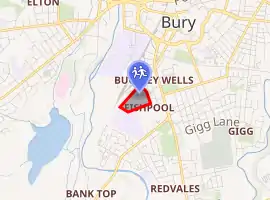Bury Church of England High School
Bury Church of England High School is a coeducational voluntary aided comprehensive school located just south of Bury town centre. The current head teacher is Mr Simon Braithwaite.[3] Awards include the Geographical Association Secondary Geography Quality Mark and the Schools Council International School Award (Full).[4]
| Bury Church of England High School | |
|---|---|
| Address | |

| |
Haslam Brow , , BL9 0TS | |
| Coordinates | 53.585381°N 2.304036°W |
| Information | |
| Type | Voluntary aided comprehensive |
| Motto | "Let your light shine" |
| Religious affiliation(s) | Church of England |
| Established | 1748 |
| Founder | Hon Rev'd John Stanley |
| Local authority | Bury |
| Department for Education URN | 105365 Tables |
| Ofsted | Reports |
| Chair of Governors | Mr Lawrence Yarwood[1] |
| Head teacher | Mr Simon Braithwaite |
| Staff | 48[2] |
| Gender | Coeducational |
| Age | 11 to 16 |
| Enrolment | c.800 pupils[2] |
| Colour(s) | Navy blue Gold |
| Publication | Grapevine |
| Website | https://www.burychurch.bury.sch.uk/ |
School history
In 1748 the Hon Rev. John Stanley, Rector of Bury and younger brother of Edward Stanley, 11th Earl of Derby, founded a charity school in the parish. The exact location of this original school is unknown, but it was most likely a borrowed property near to Bury Parish Church. Approximately eighty boys and thirty girls were taught reading, writing, arithmetic, Old Testament and New Testament knowledge and the catechism.[3]
In 1772 a variety of benefactors (including Lord Derby, John Stanley and Sir Robert Peel) donated £500 towards constructing a purpose built school building on Clough Street in Bury. Forty-two years later the school moved again, this time to the three storey £1,000 purpose-built property on Stanley Street. The school was renamed the Central National School at this time. In 1835 the school contained two hundred and eighty children aged between six and thirteen.[5]
In 1836, a second National school, called the Irwell National School, opened on the west side of Bury. By 1887 though, the Central National School and Irwell National School were closed due to inadequacy of the buildings, and so they combined in a new building in Lower Bank Street. Five years after this merge the school became co-educational.[6]
From 1906 to 1921 the school was known as Bury St. Mary’s Parochial Church of England School. In 1921, the school was renamed once again, this time to Church Central School, now with one hundred and twenty-two children aged between eleven and fourteen. This was also the year that French was introduced to the curriculum.[3]
As early as 1931 plans were made to rebuild the school but, due to the Second World War, these plans didn’t come to fruition until the early 1960s. In 1963, Lord Derby laid the foundation stone of the new building and, in September 1964, the new school opened in its current location. From that point onward it was called Bury Church of England High School.
Recent developments include the construction of F Block in the 1970s, the new sports hall in 2004, followed by the conversion of the old sports hall into the library, new music room and SEN room. In 2009 the school was awarded Specialist Status in Humanities with the focus on geography, history and RE.[4]
Curriculum
The school offers courses for both GCSEs and level 1 and 2 BTEC qualifications. All pupils study English, mathematics, science, French and religious studies to GCSE level. PE and PHSCE are compulsory (but unexamined) subjects at both KS3 and KS4. Optional subjects at GCSE include: Art & design, Computer Science, Drama, D&T, Geography, German, History and Media studies . There is the option of studying separate sciences in place of the combined science GCSE. BTEC qualifications (taught in partnership with Bury College) are ICT.
Sport
Sports played at the school, either in PE lessons or as extra curricular activities, include; athletics, association football, badminton, basketball, boxing, cricket, cross-country, hockey, netball, rounders, Rugby football, tennis, trampolining and volleyball.[7]
Specialist status
As a specialist college, the school received extra government funding to pioneer new teaching and learning methods in the humanities departments. As part of the programme, the school engaged with local primary and secondary schools, and retirement homes, and with Bury Museum in a series of geography, history and RE projects.
Notable former pupils
- Paul Stenning, biographer and ghostwriter
References
- https://www.burychurch.bury.sch.uk/governance.php
- http://www.manchestereveningnews.co.uk/news/local-news/bury-church-england-high-school-7540056
- https://burychurch.bury.sch.uk/
- Ofsted Inspection Report 2011
- The parliamentary gazetteer of England and Wales. London: A. FULLARTON & Co. 1851.
- http://discovery.nationalarchives.gov.uk/details/r/C10310294
- http://burychurch.bury.sch.uk/subjects/physical-education/